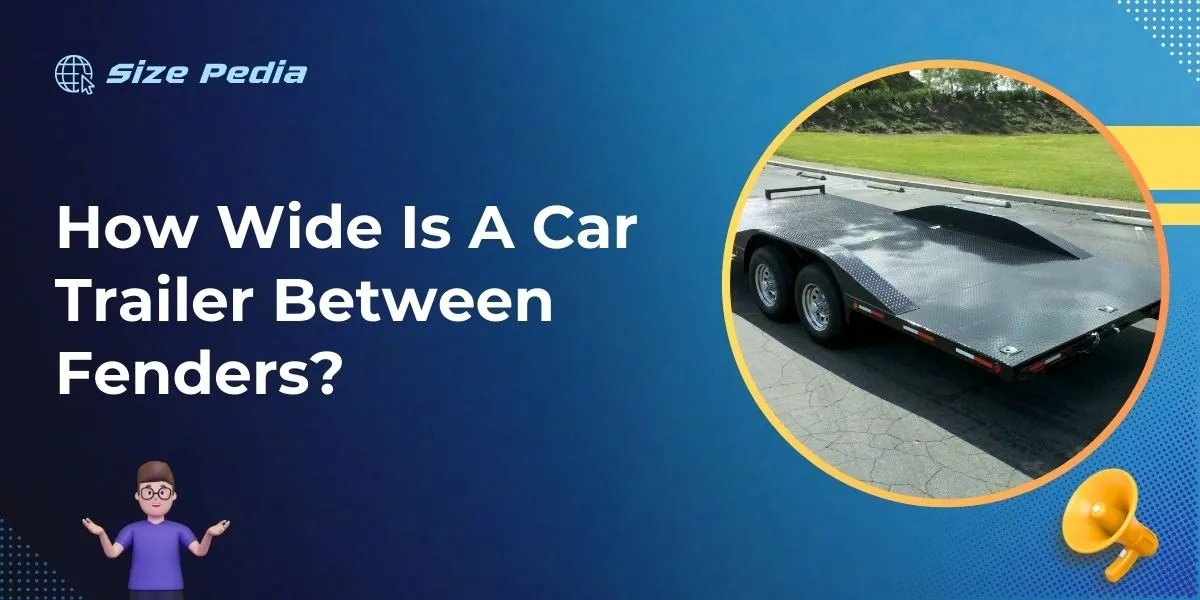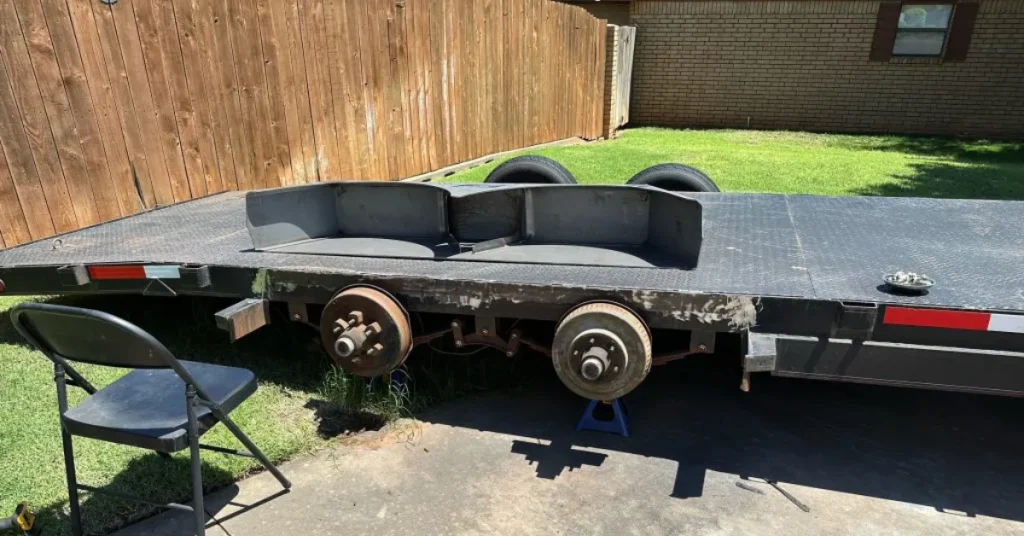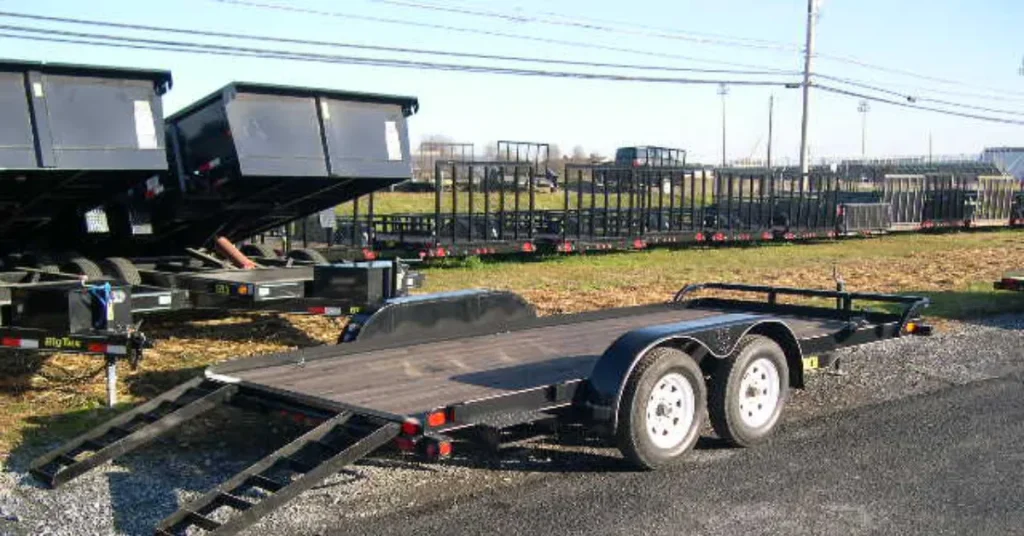A typical car trailer’s width between fenders is approximately 80 inches. This dimension can vary depending on the trailer’s design and application.
For anyone in the market for a car trailer, knowing the width between fenders is crucial as it determines the size of the vehicle that can be transported. The standard width caters to most passenger vehicles, ensuring safe and secure transit.
Whether for personal use, such as moving a car to a show, or commercial purposes, like a vehicle recovery service, trailer width is a primary specification to consider.
It directly influences the trailer’s versatility and compatibility with different car models. When selecting a trailer, remember to compare this measurement with the width of your vehicle to ensure an appropriate fit.
Safeguarding your load is paramount, and the right trailer width is the start of that process. Remember, towing safely is not just about meeting legal requirements; it’s about ensuring a stress-free journey for you and your cargo.

Introduction To Car Trailer Dimensions
Understanding car trailer dimensions is key to selecting the right one for your needs. Trailers come in various sizes, but the width between the fenders is crucial.
This measure can determine what vehicles and cargo a trailer can accommodate. It also affects maneuverability and storage. Let’s dive into why these dimensions matter and the common uses for different trailer widths.
Why Size Matters For Car Trailers
The width of a car trailer dictates several important aspects:
- Load Compatibility: Wider trailers can carry larger vehicles.
- Legal Compliance: Most regions have restrictions on maximum trailer width.
- Storage Concerns: A wider trailer requires more storage space.
Common Uses For Different Trailer Widths
Different widths serve various purposes:
| Trailer Width | Common Uses |
| 5 feet | Light-duty hauling, small cars, and motorcycles |
| 7 feet | Medium-duty work, sedans, and crossovers |
| 8.5 feet | Heavy-duty tasks, large vehicles, and commercial equipment |
Standard Widths Of Car Trailers
When considering a car trailer for transport needs, one crucial aspect is its width. Identifying the standard widths helps ensure your vehicle fits within the confines of the trailer.
These dimensions are not just numbers—they are key to safe and legal road travel. Below, explore the typical measurements encountered and how they may vary by trailer type and model.
Typical Measurements Encountered
Most car trailers feature a width that enables them to accommodate a variety of vehicles. The standard inside width between fenders is usually around 80 inches (6 feet 8 inches). This size permits most cars to be transported securely.
- Single-axle trailers often measure close to 8 feet wide.
- Tandem-axle trailers, built for heavier loads, may be wider.
- It is common to encounter custom sizes catering to specific vehicle types.
Variations By Trailer Type And Model
The width between fenders can differ based on the type and model of the trailer. Various models cater to different sizes and weights of vehicles, influencing the overall width.
| Type of Trailer | Typical Width Between Fenders (inches) |
| Utility Trailers | 72 – 83 |
| Race Car Trailers | 92 – 102 |
| Enclosed Trailers | 96 (Standard) |
Different styles, like open vs. enclosed, influence the width as well. For instance, enclosed car trailers often offer a little extra space to accommodate for the interior walls. Always check the specific model’s specs to ensure a proper fit.
Measuring Car Trailer Width

Understanding the exact width of a car trailer between fenders is crucial for safe transport. Variables like make, model, and modifications impact these measurements. This section is dedicated to guiding you through the precise measurement process.
Tools And Techniques For Accurate Measurement
Having the right tools makes any measuring task easier. For measuring your car trailer’s width, gather the following:
- Tape measure: A long and flexible ruler.
- Notepad and pen: To jot down measurements.
- Smartphone or camera: To take pictures for reference.
- Level: For ensuring your measurements are straight.
Apply these simple steps for an accurate measure:
- Position the tape measure at one fender’s outer edge.
- Extend the tape across to the opposite fender’s outer edge.
- Keep the tape level and record the measurement.
- Snap a photo for a visual record.
Factors Affecting Usable Width Between Fenders
Varying elements influence the usable space on a car trailer. Consider these:
| Factor | Impact |
| Trailer design | Determines baseline width. |
| Fender size | Cuts into usable space. |
| Tie-down points | May limit width at certain spots. |
| Wheel wells | Affect vehicle positioning. |
Understanding these factors is key to assessing a trailer’s effective width. It ensures your vehicle fits well within the safe confines of the trailer’s space.
Legal Limits And Safety Considerations
When towing a car trailer, understanding the balance between legal limits and safety is crucial. These measures ensure the safe transit of goods while remaining compliant with road regulations.
Knowing the legal width of your car trailer between fenders is not just a matter of law; it affects the trailer’s stability, handling, and overall safety on the road.
Understanding State And Federal Regulations
Each state may have different requirements for vehicle dimensions, including trailers. Beyond state laws, there are federal standards to consider.
Typically, the maximum legal width for trailers is 102 inches (8.5 feet). This limit includes the fenders but excludes certain safety equipment.
To stay updated with these regulations, consult the Department of Transportation (DOT) guidelines. Here’s a summarized list of critical points:
- Maximum width including fenders: 102 inches
- Exclusions: mirrors and safety equipment
- Varying state regulations may apply
How Width Influences Trailering Safety
The width of a car trailer can significantly impact its on-road stability. Wider trailers offer a more stable base, reducing the likelihood of tip-overs. Meanwhile, wider trailers may also be harder to maneuver in tight spaces. Here are safety considerations for trailer width:
- Center of Gravity: Wider trailers lower the center of gravity, enhancing stability.
- Wind Resistance: Height and width increase surface area, affecting handling in windy conditions.
- Maneuverability: Managing wider trailers demands skill, especially on narrow roads.
Optimizing Your Trailer Selection
Choosing the right car trailer involves many factors. The width between fenders is vital. It affects usability, legality, and compatibility.
A wide trailer may carry more, but could be harder to handle. A narrow one may limit load types. Always match the trailer’s size to your vehicle and needs.
Matching Trailer Width To Vehicle Needs
Understanding your vehicle’s towing capacity is the first step. Measure your car’s width. This helps in finding a trailer that fits without causing strain. Take note of the cargo size you plan to transport. Opt for a trailer a bit wider than your largest item for safety margins.
- Small Cars: Ideal for trailers up to 6 feet wide.
- Midsize Vehicles: Can handle trailers around 7 to 8 feet.
- Large Trucks: Suitable for trailers exceeding 8 feet.
Future-proofing Your Purchase: What To Consider
Consider long-term needs when selecting a trailer. This avoids the cost of upgrading soon. Think about:
- Anticipated Load Types: Will you carry different items?
- Legal Limits: Keep width restrictions in mind.
- Storage and Parking: Ensure you have space for a wider trailer.
By planning for the future, you choose a trailer that grows with your needs. This saves time and money.
Maintenance And Customizations

Keeping a car trailer in top condition involves regular upkeep. Proper maintenance helps ensure safe loading. Customizations can boost a trailer’s functionality. This guide delves into maintaining your trailer’s width and fenders, plus customizing for extra capacity.
Regular Checks For Width And Fender Integrity
Routine inspections are crucial for a trailer’s longevity. The width between fenders is a key dimension. It determines which vehicles fit. Here’s what to check:
- Measure the width – Use a reliable tape measure. Ensure the distance stays consistent with manufacturer specifications.
- Inspect for damage – Look for dents, bends, or rust on fenders. Address issues immediately to avoid problems.
- Secure fender bolts – Tighten loose bolts. Replace missing ones. This prevents fenders from shifting, affecting width.
Modifying Fenders For Greater Width Accommodation
To increase space, modifications are possible. Here are steps to widen the gap:
- Assess the current layout. Determine the room available for expansion.
- Consult a professional. They help with the safest way to adjust.
- Choose compatible parts. The right fenders make a difference.
- Install cautiously. Precise work ensures the new width is useful and safe.
Note: Always follow legal guidelines when modifying trailers. Check local laws to ensure compliance.
FAQs About How Wide Is A Car Trailer Between Fenders
How Wide Is The Standard Car Trailer?
A standard car trailer typically measures about 8. 5 feet in width, accommodating most vehicles comfortably.
How Wide Is The Inside Of A Trailer?
The interior width of a standard trailer is typically around 8 feet wide. This measurement can vary slightly depending on the trailer design and manufacturer.
How Wide Are Race Car Trailers?
Race car trailers typically range from 8. 5 to 10 feet in width to accommodate various vehicle sizes.
How Are Trailer Fenders Measured?
To measure trailer fenders, note the width, length, and height. Start from the widest points for width and length. Measure height straight from the mounting surface to the top.
Conclusion
Understanding the width of a car trailer between the fenders is crucial for safe towing and vehicle compatibility.
Generally, this space varies based on model and use. For exact measurements, consult the trailer’s specifications or manufacturer. Ensuring the correct width will facilitate a smoother, safer journey.
Always double-check before hitting the road!
Resources:
1. https://portal.ct.gov/dmv/vehicle-services/get-vehicle-inspection/trailer-inspection
